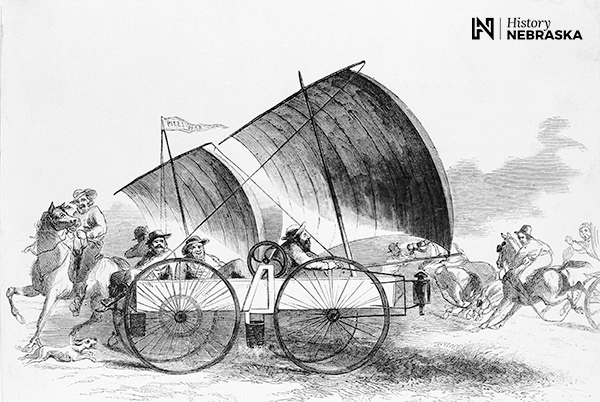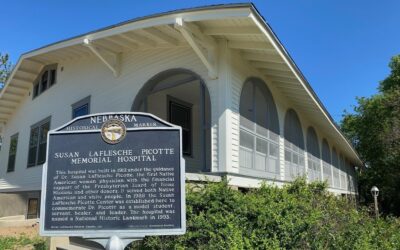
This artist’s conception of Samuel Peppard’s wind wagon as it was departing Fort Kearny in May 1860, appeared in Frank Leslie’s Illustrated Newspaper on July 7 of that year. RG1576-2 (at left).
Samuel Peppard’s wind ship was one of the most unusual vehicles in the history of Great Plains transportation. Designed by its inventor to carry freight, the craft in its trial run followed the Oregon Trail to Fort Kearny and then turned westward up the Platte River, reaching an ignominious end near what is today Fort Morgan, Colorado.
Peppard, a twenty-seven-year-old millwright, and his crew had learned in trial runs that the vehicle would be hard to control. At one time it even became airborne for a short distance. Yet, about May 10, 1860, Peppard and his crew sailed out of Oskaloosa, Kansas, with five hundred pounds of cargo, headed for the goldfields of present-day Colorado. A few days later they entered Nebraska via the Independence-St. Joe Road southeast of Rock Creek.
Files of Frank Leslie’s Illustrated Newspaper tell of the strange ship. “The Wind Ship of the Prairies: Fort Kearney, May 27, 1860,” sent by a Leslie’s correspondent to his paper from Fort Kearny, said:
“The ship hove in sight about eight o’clock in the morning, with a fresh breeze from N.E. by E.; it was running down in a westerly direction for the fort, under full sail across the green prairie. The guard, astonished at such a novel sight, reported the matter to the officer on duty, and we all turned out to view the phenomenon.”
The vehicle was described as
“a very light built wagon, the body rounded in front, something in shape like a boat, to overcome the resistance of the air. The wheels are remarkably light, large and slender, and the whole vehicle strongly built. Two masts somewhat raked carry large square sails, rigged like ship’s sails with halyards, braces, &c., &c. In front is a large coach lamp, to travel by night when the wind is favorable; and it is steered by a helm attached to the fore wheels. A crank and band wheels allow it to be propelled by hand when wind and tide are against them.”
About a week later the ship was sighted one hundred miles west of Fort Kearny by A. L. Frizzell of Iowa, who on May 31 noted the appearance of the “sail wagon” in his diary. Attaining speeds of fifteen miles an hour, Peppard cruised to within one hundred miles of Denver before his invention was demolished by a small tornado. The voyage had taken three weeks, but only nine days were spent in actual travel. He and his crew rode on into Denver by more conventional transportation powered by four-footed draft animals. – Patricia C. Gaster, Assistant Editor / Publications



